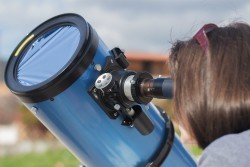Priceless, ground-based data for solar flare observers
‘Areas of disagreement are always more interesting!’ says Prof. Lyndsay Fletcher, coordinator of F-CHROMA(opens in new window) (Flare Chromospheres: Observations, Models and Archives). Since the project started in early 2014, she and her team have used every possible means to further scientific understanding of solar flares and question existing models and theories. They notably found that flare energy needed to penetrate much deeper into the solar atmosphere than expected, and they established that ionisation in the chromosphere was key to flare evolution. The project’s observations were made using space-based facilities, and most importantly ground-based ones, whose observations had not been fully exploited prior to the project’s kick-off. ‘We planned to target every opportunity to bid for observing time from ground-based facilities (including through opportunities offered by the EC-funded SOLARNET project) and were rather successful,’ Prof. Fletcher recalls. ‘With observing time on ground-based facilities in hand, we found that solar observing satellites such as NASA’s IRIS satellite were happy to support our observations where they could. Both space- and ground-based telescopes look at only small patches of the solar disk, so we needed a strategy to have the best chance of observing flares, which are sudden and unpredictable.’ Focusing on the most complex part of a group of sunspots and locations where previous flares had been reported, the team opted for a ‘sit and stare’ approach that turned out to be successful: in total they managed to obtain 30 new ground-based flare datasets, and they were able to identify optimal strategies for flare observations with the new ground-based telescopes that are coming online. Amateur solar observers, who often have access to excellent equipment, were also able to contribute. In September 2015 and July 2016, the team organised so-called F-HUNTERS campaigns to encourage these amateurs to follow F-CHROMA’s flare observation targets and send their data. ‘Generally the telescopes used by amateur observers can see a larger patch of the solar disk (but in somewhat less spatial detail) than the professional telescopes, so amateurs are able to “catch” flares that professional telescopes miss,’ Prof. Fletcher explains. Equally, amateur telescopes can observe the broadband white light — what your eye would see if you were projecting a solar image when a flare happened. This radiation is generally overlooked by professional equipment that emphasises more specific spectral emission lines, but is crucial to explaining the energetics of a flare. ‘We are thinking about how to develop this in a way that can meaningfully support observations with the next generation of ground-based solar observatories, and how amateurs’ observations could potentially be optimised to do this,’ says Prof. Fletcher. ‘The quality of some of the data they provided was very high and, with appropriate calibrations, can in principle be used to fill in gaps in our knowledge of how some particular flares developed. The whole experience, and especially the very enthusiastic response of all of our amateur colleagues, was just very uplifting for the team. It reminded us of why we do this.’ Data for everyone All in all, F-CHROMA’s careful modelling and data analysis of radiation from the chromosphere provides important answers related to increased heating, increased ionisation, flows, shocks and other changes to the plasma which are of great interest in astrophysics. The team also compared their data with two completely independent computer simulations of what happens during a flare, and found that the results were very similar. ‘We also learned what is the most effective way to “catch” a flare in observations,’ Prof. Fletcher enthuses. ‘This will be vital for flare observing in the next generation of solar telescopes, since obtaining observing time on these telescopes will be very competitive.’ Thanks to F-CHROMA, the scientific community now has access to formatted, ground-based flare data which they can use for their own research and can prepare themselves for the next generation of observatories to be rolled out as of 2019. They also have access to a suite of advanced models of the response of the flare chromosphere to different kinds of energy input, and the tools needed to simulate the radiation output for comparison with data: ‘These models, called radiation hydrodynamics models, take a lot of time, expertise and computing power to run, so instead of individual scientists having to learn how to run and “nurse” the code, we have done it for them, so they are free to concentrate on the physics interpretations,’ Prof. Fletcher explains. Thanks to the data, simulations and analysis tools being made available to the community, the team now hopes that solar researchers beyond F-CHROMA and immediate collaborators will be encouraged to embark upon solar flare studies.







